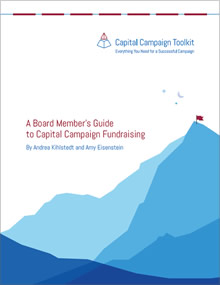Getting Your Board on Board for Your Capital Campaign: 4 Tips

Have you ever noticed how easy it is to stop a project?
And by comparison, consider what a huge amount of courage, energy and effort it takes to make a project happen.
All it takes to stop a plan is to throw a bit of sand in the gears:
- A single board member can slow things down by asking question after question for weeks until the energy wanes.
- A few board members can undermine a project by talking in the parking lot after a meeting about their concerns even though they didn’t raise them during the meeting.
- A few key board members can simply stop showing up to meetings.
It doesn’t take much for a board member to derail a campaign. Case in point — Sally.
On Board or Not? Sally’s Story
I once consulted for an organization. Sally, one of the organization’s board members, went along quietly until it came time to raise funds. Then Sally declined to give or help.
It stands to reason that if you don’t approve of the project and the plans, you will be uncomfortable in both making a meaningful gift and asking others. That’s what was going on with Sally, but she never spoke up.
I’ve seen board members undermine projects in these ways. It often happens when either the Executive Director or one prominent board member is hell-bent on pushing a project forward without making sure others are behind the project.
So, before you go very far down the capital campaign road, you’ve got to make sure that your board members believe in the project and agree with your campaign plans.
 A Board Member’s Guide to Capital Campaign Fundraising
A Board Member’s Guide to Capital Campaign Fundraising
Need help getting your board members on board with your campaign?
This guide will help you understand your own role, and that of the entire board, during a campaign. It will also answer the questions board members ask most frequently. Get it now!
4 Ways to Ensure Board Members Get On Board
Here are four things you can do to help make sure your board members are on board.
1. Involve Board Members in the Planning Process
Most capital campaigns have their origins in strategic or long-range plans that call for fundraising to pay for the project or projects outlined in the plan. Make sure that the planning process has actively engaged board members in laying out a vision for the future. That kind of planning should not be solely a staff project.
2. Talk to Each Board Member Individually
Don’t assume that every board member will speak frankly at board meetings. Some will, and some won’t.
Make sure that every board member has an opportunity to talk one-on-one with either the board chair or an appointed board member about the project. It’s your responsibility to know where they stand and understand their concerns. Here are some questions you might ask them.
3. Provide Ample Opportunity for Discussion
Make sure that when the project is presented to the board, you don’t move from presentation to voting without a structured discussion designed to encourage every board member to participate.
You might divide the group into small sub-groups and invite them to discuss specific aspects of the topic and then report back to the whole group. Or, if the board is small, you might have them identify four or five topics worthy of discussion and then explore each of them fully. For this process, you may wish to bring in an outside facilitator.
4. Call for Votes at Various Stages
Consider breaking the approval process into several stages. For example, the board might vote on purchasing the land, and then on engaging an architect, and then to approve the preliminary plans. And after that, they might be asked to vote to approve the objectives of the fundraising campaign.
This bite-size approval process helps board members get on board with the project one step at a time, increasing the likelihood that they will help move the project forward from beginning to end rather than throwing sand in the gears and undermining the project.
How to Deal with Difficult Board Members
If you have especially challenging board members, you would be well served to give them extra special attention.
Find out what concerns they have about the project in advance of the meeting. Ask if there’s anything that could happen which would alleviate those fears.
You might find out if they really want to continue to serve on the board if the organization decides to go in a direction they disagree with. Provide an opportunity for them to get off the board with dignity and grace.
As with any large project or effort, it goes more smoothly when everyone is rowing in the same direction.
Have you had trouble with difficult board members? Tell us about it in the comments.



Leave a Comment